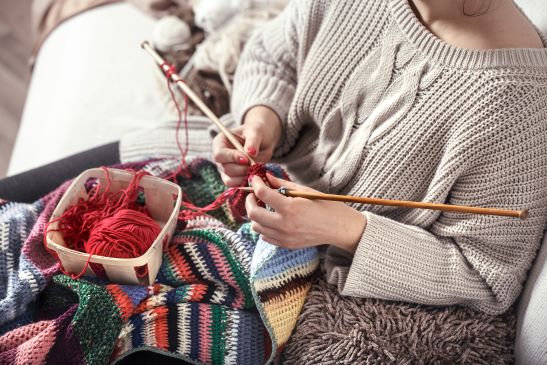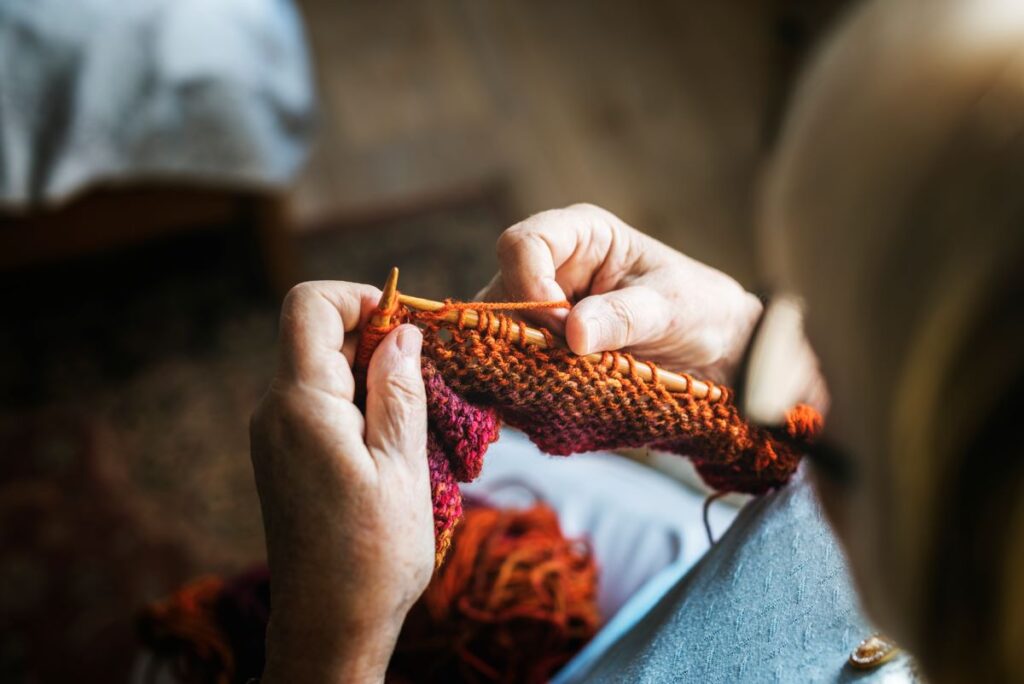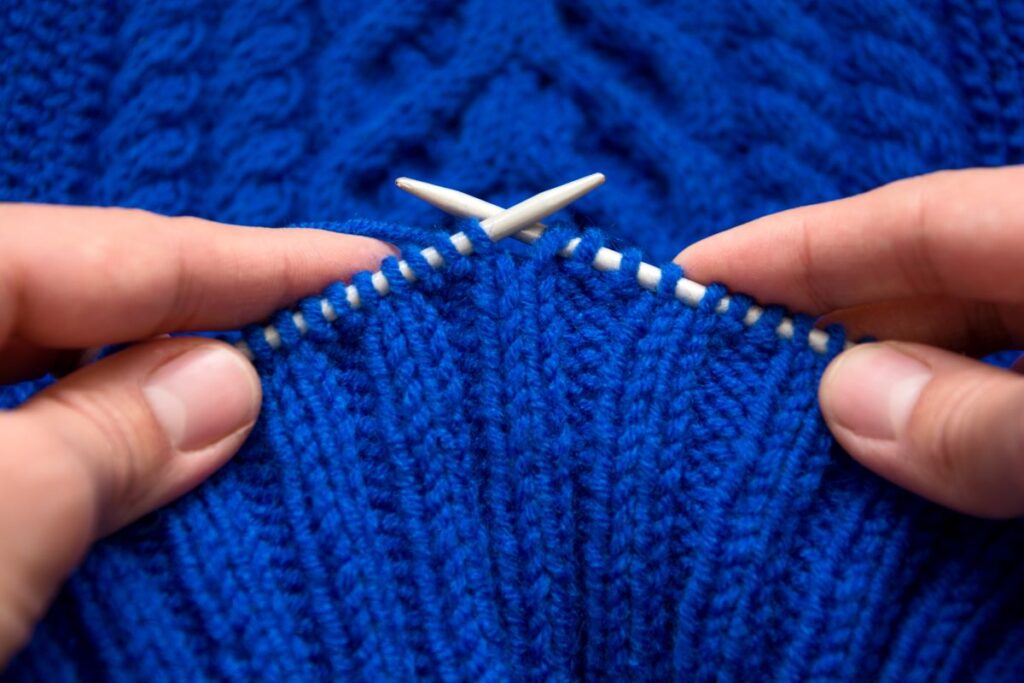When it comes to increasing stitches in knitting, there are numerous methods to choose from. Personally, one of my go-to techniques is the “Knit Front and Back” (KFB) method. It involves knitting into the front and back of the same stitch, effectively doubling the stitch count. This method is simple, quick to learn, and results in a nearly invisible increase. However, it’s crucial to understand that different methods of increasing stitches yield different effects, and that’s why exploring and mastering various techniques is invaluable.
Understanding the various methods of increasing stitches allows you to tailor your knitting projects to your desired outcome. From the subtle elegance of a
In this blog post, I’ll guide you through a variety of methods for increasing stitches in knitting, from the basics like KFB and Make One (M1), to more advanced techniques like
So, grab your needles, a skein of

Basic Methods of Increasing Stitches in Knitting
Knit Front and Back (KFB) Technique
Ah, the Knit Front and Back (KFB) technique—a nifty way to add stitches in knitting! Let me break it down for you and share some tips to help you achieve neat and tidy KFB stitches.
The KFB technique is straightforward and commonly used in knitting. It involves knitting into the front and back of the same stitch, effectively creating two stitches from one. This increase method is great for projects where you want a subtle and nearly invisible increase.
Step-by-step Instructions: KFB Technique
Now, let’s get into the step-by-step instructions for performing KFB:
- Start by knitting the first stitch on your left-hand needle just like you normally would. But here’s the twist—don’t slide it off the needle yet!
- Instead, without removing the stitch from the needle, insert your right-hand needle into the back loop of the same stitch. It might feel a bit awkward at first, but trust me, you’ll get the hang of it.
- Wrap your
yarn around the right-hand needle, just like you do for a regular knit stitch, and smoothly pull it through to the front. - Finally, slide both stitches off the left-hand needle, and ta-da! You’ve successfully completed a KFB increase.
KFB Technique Tips and Tricks
Now, let’s talk about achieving those clean and neat KFB stitches. Here are a few tips and tricks to help you out:
- Keep your tension consistent. Pay attention to the tension of your
yarn as you work through the KFB increase. A steady and even tension will ensure that your stitches look uniform and tidy. - Watch out for twisted stitches. When inserting your needle into the back loop, make sure the stitch lies flat on the needle without any twists. Twisted stitches can lead to wonky results and affect the overall appearance of your knitting.
- Practice makes perfect. If you’re new to the KFB technique, take some time to practice on a swatch or spare
yarn . Familiarize yourself with the motions and aim for consistent results. The more you practice, the easier it becomes to create neat and well-executed increases. - Consider blocking your finished project. Blocking can help even out any minor inconsistencies and give your work a polished look. It’s an excellent way to enhance the overall appearance of your stitches.
With these tips and step-by-step instructions, you’re well-equipped to conquer the KFB technique and create beautiful, increased stitches in your knitting projects. So, grab your needles, some

Make One (M1) Technique
Let’s dive into another fantastic method for increasing stitches in knitting—Make One (M1). The M1 technique is versatile and offers various options for creating new stitches. Allow me to explain the M1 technique, provide you with step-by-step instructions, and explore different variations and their best uses.
The M1 technique involves creating a new stitch between two existing stitches, effectively increasing your stitch count. It’s a subtle and nearly invisible method that seamlessly integrates into your knitting.
Step-by-Step Instructions: M1 Technique
Now, let’s walk through the step-by-step instructions for performing M1:
- Determine the location where you want to make the increase. Identify the space between two stitches on your left-hand needle.
- Insert the left-hand needle from front to back under the horizontal strand running between the two stitches, creating a new loop.
- With your right-hand needle, knit into the back loop of this new loop, just like you would for a regular knit stitch.
- Slide the newly created stitch onto your right-hand needle, and there you have it—an M1 increase!
M1 Technique Variations and When to Use Them
Now, let’s talk about the different variations of M1 and when to use them:
- M1L (Make One Left): This variation is used when you want the new stitch to slant to the left. It’s achieved by picking up the strand from front to back before knitting into the back loop.
- M1R (Make One Right): When you want the new stitch to slant to the right, use the M1R variation. Insert the left-hand needle from back to front under the strand and then knit into the back loop.
- M1A (Make One Away): M1A is a versatile variation used when you want the new stitch to be invisible, blending seamlessly into the fabric. It involves picking up the strand between the stitches in a different manner, such as twisting it or knitting into the strand below.
The choice of M1 variation depends on the effect you want to achieve in your knitting project. If you’re working on a pattern that includes shaping or intricate stitch patterns, refer to the pattern instructions for guidance on which M1 variation to use.
Experimenting with different M1 variations and understanding their effects allows you to customize your knitting projects. It adds a touch of elegance and professionalism to your work while maintaining the integrity of the design.
Advanced Methods of Increasing Stitches In Knitting
Yarn Over (YO)
Let’s unravel the captivating technique of
Yarn Over (YO) Knitting Technique Explained
In a YO, you create a new stitch by simply wrapping the
Step-by-Step Instructions for Performing YO
Performing YO is a breeze. Here’s a simple guide to follow:
- While working on the right side of your knitting, bring the
yarn to the front of your work as if you were going to purl a stitch. - Instead of actually purling a stitch, keep the
yarn in front and bring it over the top of your right-hand needle, creating a loop. - Now, simply continue with your next stitch as directed in the pattern, whether it’s a knit or purl stitch.
That’s it! You’ve successfully performed a YO increase. It’s important to note that YO doesn’t use an existing stitch to create a new one, but rather adds an extra stitch by wrapping the
Incorporating YO in lace patterns and decorative stitches:
YO is a key element in lace knitting. By strategically placing YOs in your pattern, you can create intricate motifs, openwork designs, and flowing curves. YOs are often combined with decreases to form eyelet patterns, delicate scalloped edges, or intricate lace panels.
When working on lace patterns or decorative stitches, your pattern instructions will guide you on where to place the YOs and how they interact with the surrounding stitches. YOs may be paired with knit two together (K2tog), slip slip knit (SSK), or other decreases to balance the lace and maintain the desired stitch count.
The beauty of YO is its versatility. It can be used to create decorative accents in various projects, such as shawls, scarves, cardigans, and even socks. With a bit of practice and experimentation, you’ll discover the infinite possibilities of YO in your knitting.
Lifted Increase Knitting Technique
Let’s explore the fascinating technique of lifted increases—a method of increasing stitches in knitting that offers versatility and creates a beautiful effect. In this section, I’ll explain the lifted increase technique, provide step-by-step instructions, and compare different types of lifted increases and their effects.
Lifted Increase Technique Explained
Lifted increases, also known as raised increases, are a group of techniques that involve lifting a strand of
Step-by-step instructions for performing lifted increases
Let’s go through the steps to perform a basic lifted increase:
- Identify the stitch below the next stitch on your left-hand needle. This is the “lifted” stitch.
- Insert the right-hand needle from the back to the front under the lifted stitch.
- Place the lifted stitch onto the left-hand needle.
- Knit the lifted stitch through the back loop, just like a regular knit stitch.
Congratulations! You have successfully performed a lifted increase.
Comparing different types of lifted increases and their effects
There are variations of lifted increases, each offering a slightly different effect. Let’s explore two common types:
- Lifted Increase Right (LIR): In this variation, you lift the right leg of the stitch below the next stitch and knit it through the back loop. LIR creates a right-leaning increase, which is ideal for shaping garments or achieving diagonal lines in your knitting.
- Lifted Increase Left (LIL): For LIL, you lift the left leg of the stitch below the next stitch and knit it through the back loop. This creates a left-leaning increase, perfect for mirroring the right-leaning increases or creating symmetrical shaping.
The choice between LIR and LIL depends on the desired effect and the pattern instructions. By strategically incorporating these lifted increases, you can add texture, shape, and visual interest to your knitting projects.
When comparing lifted increases to other methods like KFB or YO, lifted increases have the advantage of being less noticeable, especially when used in more intricate stitch patterns. They seamlessly blend into the fabric, creating a professional finish.
Experimenting with different types of lifted increases will allow you to explore their unique effects and choose the one that best suits your project. They are particularly useful for patterns that require subtle shaping or for achieving symmetrical designs.

Increasing Stitches in Different Stitch Patterns
Increasing Stitches in Stockinette Stitch
When it comes to knitting, one of the techniques I often find myself using is increasing stitches in stockinette stitch. It’s a fundamental skill that allows me to shape my projects and add flair to my designs. However, I’ve encountered a few challenges along the way. Today, I want to share with you some tips on overcoming these challenges and maintaining stitch consistency while increasing in stockinette stitch.
Challenges and Tips for Increasing Stitches in Stockinette Stitch:
- Consistent tension: One of the challenges I faced when increasing stitches in stockinette stitch was maintaining a consistent tension. Sometimes, I would unintentionally pull the
yarn too tightly or leave the stitches too loose, resulting in an uneven and unattractive fabric. To overcome this, I learned to be mindful of my tension and ensure that I’m not exerting excessive force when making the new stitches. It’s important to find that sweet spot where the tension matches the rest of my knitting. - Avoiding gaps: Another challenge I encountered was the tendency to create gaps between the increased stitches and the adjacent ones. These gaps can be quite noticeable and detract from the overall appearance of the fabric. To address this, I learned to ensure that the new stitch is snug against the neighboring stitches. By making sure there’s no space between them, I can eliminate those pesky gaps and achieve a smooth and seamless look.
- Counting stitches: As I increased the number of stitches, it became increasingly important to keep track of my stitch count. It’s easy to get carried away in the excitement of creating new stitches and lose count, resulting in uneven rows or incorrect shaping. To tackle this challenge, I developed the habit of periodically counting my stitches to ensure I’m on the right track. I find it helpful to use stitch markers to mark specific points in my knitting where I need to increase, making it easier to keep count and maintain accuracy.
Maintaining Stitch Consistency While Increasing in Knitting
While increasing stitches in stockinette stitch, it’s crucial to maintain the consistency of the existing fabric. Here are a few tips I’ve learned along the way:
- Choose the appropriate increase method: There are various methods for increasing stitches, such as KFB (Knit Front and Back) or M1 (Make One). When working in stockinette stitch, I select the increase method that blends seamlessly with the fabric. I consider the type of increase that will best match the surrounding stitches, allowing the new stitches to flow harmoniously within the existing pattern.
- Consistent stitch orientation: When making the new stitches, it’s important to pay attention to their orientation. To ensure stitch consistency, I make sure that the new stitches align with the surrounding ones. This means knitting through the back loop or twisting the stitches if necessary, to maintain a uniform appearance throughout my work.
- Practice on a swatch: If I’m unsure about how the increases will affect the stockinette fabric, I take the time to create a swatch and practice the increases before incorporating them into my actual project. This allows me to familiarize myself with the techniques, adjust my tension if needed, and ensure that the increased stitches seamlessly blend into the fabric.
Increasing Stitches in Ribbing
When it comes to knitting, one stitch pattern I often find myself working with is ribbing. Whether it’s for the cuffs of a sweater or the edges of a hat, ribbing adds a touch of elasticity and structure to my projects. But what happens when I need to increase stitches within a ribbing pattern? It can be a bit tricky, but through my own experiences, I’ve learned some valuable considerations and techniques for successfully increasing stitches while keeping the rib pattern intact.
Considerations for Increasing Stitches in Ribbing:
- Maintaining the rib pattern: Ribbing consists of alternating knit and purl stitches, creating a textured and stretchy fabric. When increasing stitches in ribbing, it’s crucial to ensure that the rib pattern remains consistent and undisturbed. The goal is to seamlessly incorporate the new stitches while preserving the established rhythm of knits and purls.
- Balancing tension: One consideration I’ve discovered is the importance of maintaining consistent tension throughout the ribbing. When increasing, it’s easy to unintentionally tighten or loosen the
yarn , resulting in stitches that appear uneven or out of place. To overcome this challenge, I focus on keeping my tension steady and matching the tension of the surrounding stitches. This helps to create a cohesive fabric where the new stitches blend seamlessly with the existing ones.
Techniques for Keeping the Rib Pattern Intact:
- Paired increases: To keep the rib pattern intact while increasing, I use paired increases that align with the knit and purl stitches. For example, when encountering a knit stitch, I use a knit increase method such as KFB (Knit Front and Back). This helps to maintain the desired knit stitch appearance and prevents any disruption to the ribbing pattern. Similarly, when encountering a purl stitch, I opt for a purl increase method like PFB (Purl Front and Back).
- Adjusting stitch sequence: Depending on the specific ribbing pattern and the number of stitches I need to increase, I sometimes adjust the stitch sequence slightly to accommodate the increases. For instance, if I need to add multiple stitches, I might work additional knits or purls before or after the increase to maintain the established rib pattern. This adjustment allows me to seamlessly integrate the new stitches while keeping the overall symmetry of the ribbing intact.
- Consistency in stitch orientation: Maintaining a consistent stitch orientation is key to preserving the ribbing pattern. When working the increased stitches, I make sure to match the stitch orientation of the adjacent stitches. This means knitting through the back loop (tbl) or purling through the back loop (ptbl) as necessary to keep the stitches consistent and in line with the surrounding ribbed fabric. By paying attention to stitch orientation, I can achieve a polished and professional look.
Increasing stitches in ribbing requires careful attention to detail, but with these considerations and techniques, it becomes a manageable task. By focusing on maintaining the rib pattern, balancing tension, using paired increases, adjusting stitch sequences when needed, and ensuring consistent stitch orientation, I can confidently add stitches to my ribbed projects while keeping the integrity of the stitch pattern intact.
Increasing Stitches in Lace Patterns
As a passionate knitter, I have always been drawn to the delicate beauty of lace patterns. There’s something captivating about the intricate twists, eyelets, and openwork that lace creates. However, when it comes to increasing stitches within a lace pattern, I must admit that it can be a bit challenging. Over time, I have encountered several obstacles, but through experimentation and practice, I have discovered solutions and developed techniques to maintain the pattern’s integrity while increasing stitches. In this article, I’ll share my experiences, challenges, solutions, and tips for successfully increasing stitches in lace patterns.
Challenges and Solutions for Increasing Stitches in Lace
- Lace pattern disruption: One of the primary challenges I faced was the risk of disrupting the lace pattern while increasing stitches. Lace patterns rely on a delicate balance of yarnovers, decreases, and intricate stitch combinations. Simply adding stitches without careful consideration can throw off the pattern’s symmetry and aesthetic appeal. To overcome this challenge, I pay close attention to the lace chart or written instructions, identifying the stitch sequences and the relationships between yarnovers and decreases. This allows me to strategically incorporate the increased stitches while preserving the pattern’s flow and rhythm.
- Maintaining stitch definition: Another challenge is maintaining the stitch definition and clarity within the lace pattern. When adding stitches, it’s essential to ensure that the increased stitches blend seamlessly with the existing ones, without distorting or obscuring the delicate motifs. To address this, I choose increase methods that complement the surrounding lace stitches. For example, using a yarnover increase (YO) often works well in lace patterns, as it creates a new stitch that naturally integrates with the yarnovers already present in the design.
Tips for Maintaining Pattern Integrity During Increases
- Preparing with lifelines: Lace patterns can be intricate and unforgiving. To safeguard against potential mistakes or difficulties, I always incorporate lifelines before starting the increase rows. Lifelines are strands of contrasting
yarn or thread that I thread through the stitches of a particular row. If I make an error or need to unravel my work, I can easily pick up stitches from the lifeline and resume knitting without losing my place in the pattern. Lifelines provide a safety net and peace of mind during the increasing process. - Consistency in stitch tension: Consistency in stitch tension is crucial for maintaining the integrity of a lace pattern. When increasing stitches, it’s easy to inadvertently alter the tension, resulting in uneven and inconsistent stitches. To mitigate this, I pay close attention to my tension throughout the process. I ensure that each stitch is neither too loose nor too tight, allowing the lace motifs to retain their crispness and definition.
- Taking it slow and practicing patience: Increasing stitches in lace patterns requires focus and patience. It’s important not to rush through the process but rather take it one stitch at a time. I work at a slower pace, carefully executing each increase while ensuring that the surrounding stitches are not compromised. Taking breaks, stepping back, and admiring progress can help maintain motivation and ensure the desired outcome.
Increasing stitches in lace patterns is a beautiful challenge that allows me to add complexity and dimension to my knitting projects. By overcoming challenges such as pattern disruption and maintaining stitch definition, and by following tips like using lifelines, maintaining stitch tension, and practicing patience, I can confidently navigate the increasing process while preserving the delicate beauty of lace.
Troubleshooting and Common Mistakes when Increasing Stitches in Knitting
Identifying and Fixing Accidental Increases
- Extra stitches: Accidental increases can happen when you unknowingly create additional stitches while working. These extra stitches can disrupt the stitch count and affect the overall shape and symmetry of your project. To identify and fix accidental increases, carefully count your stitches at regular intervals, comparing them to the pattern instructions. If you find extra stitches, you can simply decrease them by working a corresponding decrease stitch, such as knitting two stitches together (K2tog) or purling two stitches together (P2tog).
- Make sure of stitch markers: Placing stitch markers can help you keep track of specific sections or pattern repeats in your work. If you notice a sudden increase in stitch count within a particular section, it may indicate accidental increases. By using stitch markers strategically, you can isolate the problem area and address the extra stitches accordingly.
Avoiding Gaps or Holes When Increasing Stitches:
- Tighten the stitch after the increase: One common mistake when increasing stitches is to leave a gap or hole between the new stitches and the surrounding ones. To avoid this, after performing the increase stitch (e.g.,
yarn over or make one), make sure to tighten theyarn slightly by pulling it gently. This tightens the stitch and minimizes any potential gaps or holes. - Properly seat the new stitch: When working an increase, it’s essential to ensure that the new stitch is properly seated on the needle. If the stitch is twisted or not sitting correctly, it can lead to gaps or uneven tension. Take a moment to double-check that the new stitch is correctly oriented and sitting neatly on the needle before proceeding with your knitting.
Undoing and Correcting Mistakes in Stitch Increases
- Tink back: “Tinking” is the process of undoing stitches one by one, working backward. If you realize that you made a mistake in your stitch increases, you can use the “tink” method to carefully unknit each stitch until you reach the point where the mistake occurred. This allows you to correct the error and continue knitting from the correct stitch count.
- Use a lifeline: If you’ve made multiple increases and need to correct them, it can be challenging to unravel without losing your place in the pattern. To prevent this, consider using a lifeline. A lifeline is a thin strand of contrasting
yarn or thread that you thread through a row of stitches. If you need to undo your work, you can safely unravel back to the lifeline and then pick up the stitches from there. This method ensures that you can easily reestablish your stitch count and correct any mistakes in your increases.
Remember, mistakes happen to every knitter, and the key is to approach them with patience and a willingness to learn. By identifying and fixing accidental increases, avoiding gaps or holes when increasing stitches, and knowing how to undo and correct mistakes, you’ll be equipped with the knowledge and skills to tackle any issues that may arise during the increasing process.
Conclusion
Increasing stitches in knitting is an essential skill that allows you to shape your projects, experiment with stitch patterns, and add decorative elements. With practice, patience, and a willingness to learn from your experiences, you can master the art of increasing stitches and elevate your knitting projects to new heights. So, grab your needles, embrace the joy of creating, and let your imagination soar as you incorporate increased stitches into your knitting endeavors. Happy knitting!
- Master Crochet Stitches for Cozy Creations - January 23, 2024
- Half Double Crochet Guide for Cozy Creations - January 23, 2024
- Elevate Your Space with Unique Macrame Creations - January 23, 2024

